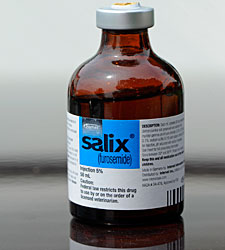Forum: No Easy Way to Proceed on Lasix Issue
Image:

Description:
At a forum designed to educate state regulators about furosemide, the very people the presentations were designed to enlighten may well have left with more questions than answers.
Hosted by the New York State Gaming Commission in Saratoga Springs, N.Y., Aug. 25, the program brought together veterinarians and the current research regarding the use of the anti-bleeder medication, also known as Lasix or Salix, and their experiences working with horses that suffer from exercise-induced pulmonary hemorrhage.
NYSGC executive director Rob Williams said the forum was initiated to educate New York's regulators, none of whom, he said, have any background in horse racing.
In a videotaped message, Bennett Liebman of Albany Law School and the former deputy secretary for racing and gaming for New York State, noted the importance of consistency of equine performance for the sport's bettors, then said a focus on horse health and what "fans want and need" will lead to "doing the right thing" with regard to furosemide.
Subsequent panels suggested it might not be quite so easy given the lack of research on the use of furosemide in racehorses and the divergent opinions by practitioners.
A review of the existing research by veterinarians Corinne Sweeney and Paul Morley, of the New Bolton Center at the University of Pennsylvania and Colorado State University, respectively, suggested that some of the most fundamental questions about EIPH and the use of furosemide remain unanswered, among them the effect of EIPH on the long-term health of horses and the reasons for its efficacy in reducing bleeding.
Sweeney and Morley also noted that much of the evidence revealed by published studies is characterized as of only "moderate" quality, on a scale of low, moderate, and high, largely because of the small sample sizes and the small number of studies.
Morley said virtually no research exists on alternatives to reducing EIPH, while he concluded that the evidence that furosemide does so can be rated "high quality." And while studies show evidence that administration of furosemide four hours before a race can affect performance, the reasons for improvement are unclear, possibly a result of either weight loss from the medication's diuretic qualities or a result of increased respiratory performance because of mitigated bleeding.
Moderated by NYSGC equine medical director Dr. Scott Palmer, a panel of veterinarians offered a variety of opinions and impressions based on their experience, with some decrying what they see as detrimental side effects to use of the furosemide and others insisting they saw no downside to using it. Several called for more research, particularly into alternatives to furosemide.
In July the American Association of Equine Practitioners announced it would launch such a study with an eye toward eliminating the use of furosemide on race day.
The gaming commission is the regulatory body for horse racing in New York state, and any changes to existing practice on race-day medication would be initiated and overseen by its members. Commissioners asked panelists a variety of questions, and several admitted they were essentially starting from scratch in their knowledge of the medication and how it is used.
While panelists offered a variety of opinions, they were unanimous in their assessment that it would be "suicide" for any individual state to make unilateral, significant changes to further restrict the use of furosemide.
The program continued in the afternoon with a panel of owners and trainers, and a discussion of what the NYSGC should consider going forward.
